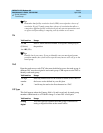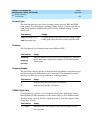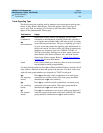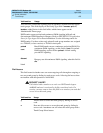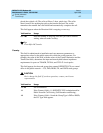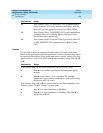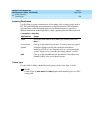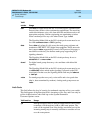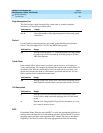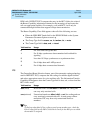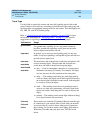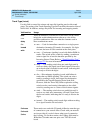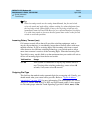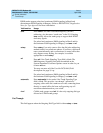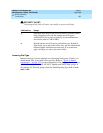
DEFINITY ECS Release 8.2
Administrator’s Guide
555-233-506
Issue 1
April 2000
Screen reference
980Trunk Group
17
Auth Code
This field affects the level of security for tandemed outgoing calls at your switch.
This field appears if the Direction field is incoming or two-way, and it can only be
y if the Authorization Codes field is y on the System-Parameters
Customer-Options screen.
Valid
entries Usage
avd
Enter avd for applications that mix voice and Digital Communication
Protocol data, such as video conferencing applications. The receiving
switch discriminates voice calls from data calls and directs each to an
appropriate endpoint. Neither originating nor terminating switches
insert a modem poll for any calls when Comm Type is
avd.
The Signaling Mode field on the DS1 circuit pack screen must be set
for either
common-chan or CAS signaling.
data
Enter data only when all calls across the trunk group originate and
terminate at DEFINITY ECS digital data endpoints. Public networks
don’t support
data: supported by Lucent’s DCP protocol, this entry is
used almost exclusively for the data trunk group supporting DCS
signaling channels.
The Signaling Mode field on the DS1 circuit pack may be set to
robbed-bit or common-chan.
rbavd
For digital trunk groups that carry voice and data with robbed-bit
signaling.
The Signaling Mode field on the DS1 circuit pack screen must be set
to
robbed-bit unless mixed mode signaling is allowed on the DS1
circuit pack. In that case, the Signaling Mode field may be
isdn-ext
or
isdn-pri.
voice
For trunk groups that carry only voice traffic and voice-grade data
(that is, data transmitted by modem). Analog trunk groups must use
voice.
Valid entries Usage
y/n
Enter y to require callers to enter an authorization code in order
to tandem a call through an AAR or ARS route pattern. The
code will be required even if the facility restriction level of the
incoming trunk group is normally sufficient to send the call out
over the route pattern.



